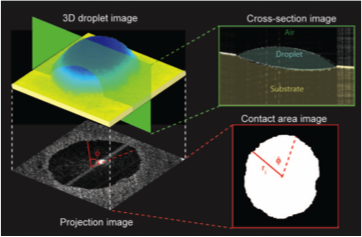Material Wettability |
|
|---|---|
|
Wettability or wetting is the ability of a liquid to maintain contact with a solid surface, resulting from intermolecular interactions when the two are brought together. The degree of wetting (wettability) is determined by a force balance between adhesive and cohesive forces. OCT is an interesting and complementary tool for present wetting characterization methods. Examples of applications where solid surface wettability plays a crucial role are body implants, contact lenses, biomaterials, offset printing processes, packaging, semiconductor wafers, electronic products, biofilm growth, fabrics, superhydrophobic surfaces, self-cleaning and non-sticky surfaces. In addition, as with wetting properties of macroscopic surfaces, the wettability of smaller objects like fibers, micro- and nanoparticles plays an important role in stabilization and performance of many products, such as composites, paints & coatings, inks, cosmetics, pharmaceuticals and food products. Additional general information: Wettability characterization method based on optical coherence tomography imaging |
3D investigation of a droplet on a solid substrate.
|




